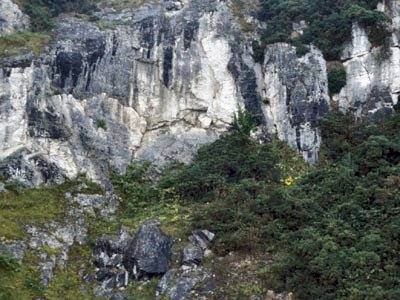Earth Science Conservation Review
| Glenarm Quarry | Antrim |
| Site Type: | Quarry (disused) |
| Site Status: | ESCR |
| Council area: | Larne Borough Council |
| Grid Reference: | D304156 |
| Google maps: | 54.9713,-5.96366 |
| Rocks | |
|---|---|
| Rock Age: | Cretaceous (Campanian) |
| Rock Name: | Glenarm Chalk Member, Ulster White Limestone Formation |
| Rock Type: | Flint, Limestone |
| Interest | |
| Fossil Groups: | Belemnite, Sponge |
| Other interest: | Marine sediments |
Summary of site:
Every named rock division is defined by reference to an actual site where its main features can be examined. Such sites are called ‘stratotypes' and Glenarm Quarry is the site of the stratotype of the Glenarm Chalk Member, one division of the Ulster White Limestone Formation.
The Ulster White Limestone has 14 members and the Glenarm Chalk is the eighth from the base. In the quarry it is a little over 8m thick. Its base is defined by a prominent bedding plane immediately above the Altachuile Breccia in the Ballintoy Chalk. Four well defined beds make up the member and there are three recognisably different styles of flint development. Nodular flints occur at the base and there are two levels of tabular flints above, the upper belt particularly massive. Locally there is a minor level of tabular flints, about 3cm thick, just below the top of the member and at this level there are many characteristic fragments of Inoceramus (a thick, prismatic-shelled bivalve mollusc). The top of the member is defined by a strongly marked bedding plane similar to that at the base.
In the early stages of chalk sedimentation there were two basins of deposition in the Co. Antrim area separated by a north-east/south-west trending ridge of land extending from the Fair Head – Glendun area towards Maghera. The chalk ocean overwhelmed the ridge in Larry Bane Chalk times, two members below the Glenarm Chalk, so this member was formed on the continuous Ulster White Limestone seabed. It shares some features with the equivalent division in the English chalk of the Norfolk area, indicating widespread influences.
The Ulster White Limestone was formed in the Cretaceous period and the Glenarm Chalk Member dates from the middle of the Campanian stage, around 78 million years ago, towards the close of the period.
Stratotypes are the essential building blocks of geological history, key components that must be conserved. The obvious threats to this site are dumping and overgrowth.
The Ulster White Limestone has 14 members and the Glenarm Chalk is the eighth from the base. In the quarry it is a little over 8m thick. Its base is defined by a prominent bedding plane immediately above the Altachuile Breccia in the Ballintoy Chalk. Four well defined beds make up the member and there are three recognisably different styles of flint development. Nodular flints occur at the base and there are two levels of tabular flints above, the upper belt particularly massive. Locally there is a minor level of tabular flints, about 3cm thick, just below the top of the member and at this level there are many characteristic fragments of Inoceramus (a thick, prismatic-shelled bivalve mollusc). The top of the member is defined by a strongly marked bedding plane similar to that at the base.
In the early stages of chalk sedimentation there were two basins of deposition in the Co. Antrim area separated by a north-east/south-west trending ridge of land extending from the Fair Head – Glendun area towards Maghera. The chalk ocean overwhelmed the ridge in Larry Bane Chalk times, two members below the Glenarm Chalk, so this member was formed on the continuous Ulster White Limestone seabed. It shares some features with the equivalent division in the English chalk of the Norfolk area, indicating widespread influences.
The Ulster White Limestone was formed in the Cretaceous period and the Glenarm Chalk Member dates from the middle of the Campanian stage, around 78 million years ago, towards the close of the period.
Stratotypes are the essential building blocks of geological history, key components that must be conserved. The obvious threats to this site are dumping and overgrowth.
| Enlander, I., Dempster, M. & Doughty, P., 2025. Glenarm Quarry, County Antrim, site summary. [In] Earth Science Conservation Review. https://www.habitas.org.uk/escr/summary.php?item=1213. Accessed on 2025-04-03 |
| Previous Site | Next Site |
